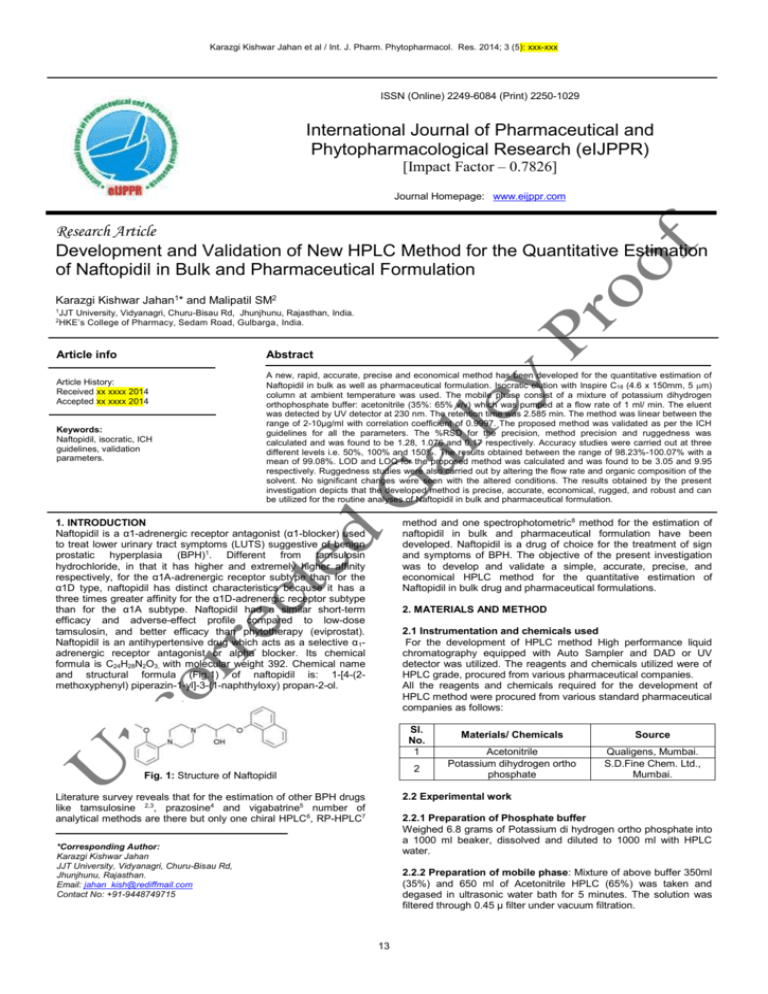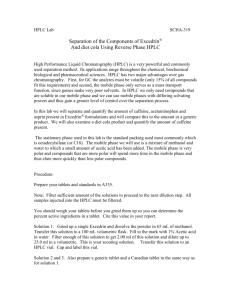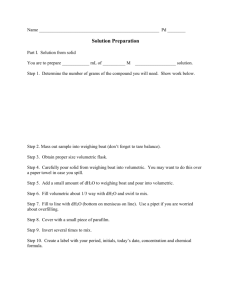Karazgi Kishwar Jahan et al / Int. J. Pharm. Phytopharmacol. Res
advertisement

Karazgi Kishwar Jahan et al / Int. J. Pharm. Phytopharmacol. Res. 2014; 3 (5): xxx-xxx ISSN (Online) 2249-6084 (Print) 2250-1029 International Journal of Pharmaceutical and Phytopharmacological Research (eIJPPR) [Impact Factor – 0.7826] Journal Homepage: www.eijppr.com Research Article Development and Validation of New HPLC Method for the Quantitative Estimation of Naftopidil in Bulk and Pharmaceutical Formulation Karazgi Kishwar Jahan1* and Malipatil SM2 1 JJT University, Vidyanagri, Churu-Bisau Rd, Jhunjhunu, Rajasthan, India. HKE’s College of Pharmacy, Sedam Road, Gulbarga, India. 2 Article info Abstract Article History: Received xx xxxx 2014 Accepted xx xxxx 2014 Keywords: Naftopidil, isocratic, ICH guidelines, validation parameters. A new, rapid, accurate, precise and economical method has been developed for the quantitative estimation of Naftopidil in bulk as well as pharmaceutical formulation. Isocratic elution with Inspire C18 (4.6 x 150mm, 5 m) column at ambient temperature was used. The mobile phase consist of a mixture of potassium dihydrogen orthophosphate buffer: acetonitrile (35%: 65% v/v) which was pumped at a flow rate of 1 ml/ min. The eluent was detected by UV detector at 230 nm. The retention time was 2.585 min. The method was linear between the range of 2-10µg/ml with correlation coefficient of 0.9997. The proposed method was validated as per the ICH guidelines for all the parameters. The %RSD for the precision, method precision and ruggedness was calculated and was found to be 1.28, 1.076 and 0.17 respectively. Accuracy studies were carried out at three different levels i.e. 50%, 100% and 150%. The results obtained between the range of 98.23%-100.07% with a mean of 99.08%. LOD and LOQ for the proposed method was calculated and was found to be 3.05 and 9.95 respectively. Ruggedness studies were also carried out by altering the flow rate and organic composition of the solvent. No significant changes were seen with the altered conditions. The results obtained by the present investigation depicts that the developed method is precise, accurate, economical, rugged, and robust and can be utilized for the routine analyses of Naftopidil in bulk and pharmaceutical formulation. method and one spectrophotometric8 method for the estimation of naftopidil in bulk and pharmaceutical formulation have been developed. Naftopidil is a drug of choice for the treatment of sign and symptoms of BPH. The objective of the present investigation was to develop and validate a simple, accurate, precise, and economical HPLC method for the quantitative estimation of Naftopidil in bulk drug and pharmaceutical formulations. 1. INTRODUCTION Naftopidil is a α1-adrenergic receptor antagonist (α1-blocker) used to treat lower urinary tract symptoms (LUTS) suggestive of benign prostatic hyperplasia (BPH)1. Different from tamsulosin hydrochloride, in that it has higher and extremely higher affinity respectively, for the α1A-adrenergic receptor subtype than for the α1D type, naftopidil has distinct characteristics because it has a three times greater affinity for the α1D-adrenergic receptor subtype than for the α1A subtype. Naftopidil had a similar short-term efficacy and adverse-effect profile compared to low-dose tamsulosin, and better efficacy than phytotherapy (eviprostat). Naftopidil is an antihypertensive drug which acts as a selective α 1adrenergic receptor antagonist or alpha blocker. Its chemical formula is C24H28N2O3, with molecular weight 392. Chemical name and structural formula (Fig.1) of naftopidil is: 1-[4-(2methoxyphenyl) piperazin-1-yl]-3-(1-naphthyloxy) propan-2-ol. 2. MATERIALS AND METHOD 2.1 Instrumentation and chemicals used For the development of HPLC method High performance liquid chromatography equipped with Auto Sampler and DAD or UV detector was utilized. The reagents and chemicals utilized were of HPLC grade, procured from various pharmaceutical companies. All the reagents and chemicals required for the development of HPLC method were procured from various standard pharmaceutical companies as follows: Sl. No. 1 2 Fig. 1: Structure of Naftopidil Materials/ Chemicals Source Acetonitrile Potassium dihydrogen ortho phosphate Qualigens, Mumbai. S.D.Fine Chem. Ltd., Mumbai. 2.2 Experimental work Literature survey reveals that for the estimation of other BPH drugs like tamsulosine 2,3, prazosine4 and vigabatrine5 number of analytical methods are there but only one chiral HPLC6, RP-HPLC7 2.2.1 Preparation of Phosphate buffer Weighed 6.8 grams of Potassium di hydrogen ortho phosphate into a 1000 ml beaker, dissolved and diluted to 1000 ml with HPLC water. *Corresponding Author: Karazgi Kishwar Jahan JJT University, Vidyanagri, Churu-Bisau Rd, Jhunjhunu, Rajasthan. Email: jahan_kish@rediffmail.com Contact No: +91-9448749715 2.2.2 Preparation of mobile phase: Mixture of above buffer 350ml (35%) and 650 ml of Acetonitrile HPLC (65%) was taken and degased in ultrasonic water bath for 5 minutes. The solution was filtered through 0.45 µ filter under vacuum filtration. 13 Karazgi Kishwar Jahan et al / Int. J. Pharm. Phytopharmacol. Res. 2014; 3 (5): xxx-xxx 2.2.3 Diluent: Mobile phase was used as diluent. Accuracy: 2.2.4 Preparation of the Naftopidil Standard and Sample Solution: Standard Solution Preparation: Accurately weighed and transferred 10mg of Naftopidil working standard into a 100 ml volumetric flask, about 70 ml of diluent was added and sonicated to dissolve it completely and volume was made up to the mark with the same solvent. (Stock solution). 0.6 ml of the above stock solution was pipetted into a 10ml volumetric flask and diluted up to the mark with diluent. Mixed well and filtered through 0.45µm filter. Sample Solution Preparation: About 5 Naftopidil tablets were weighed and average weight was calculated. Accurately weighed and transferred the sample equivalent to 10 mg of Naftopidil into a 100 ml volumetric flask. About 70 ml of diluent was added and sonicated to dissolve it completely and volume was made up to the mark with diluent. Mixed well and filtered through 0.45µm filter. Further pipetted 0.6 ml of the above stock solution into a 10ml volumetric flask and diluted up to the mark with diluent. Mixed well and filtered through 0.45µm filter. Preparation of stock solution: Accurately weighed and transferred 10 mg equivalent of Naftopidil working standard into a 100 ml volumetric flask about 70 ml of diluent was added and sonicated to dissolve it completely and volume was made up to the mark with the same solvent. (Stock solution). Preparation of Sample solutions: a)For preparation of 50% solution (With respect to target Assay concentration): Accurately weighed and transferred 4.85 mg of Naftopidil API sample into a 100 ml volumetric flask about 70 ml of diluent was added and sonicated to dissolve it completely and volume was made up to the mark with the same solvent. (Stock solution) b)For preparation of 100% solution (With respect to target Assay concentration): Accurately weighed and transferred 10.0mg of Naftopidil API sample into a 100 ml volumetric flask about 70 ml of diluent was added and sonicated to dissolve it completely and volume was made up to the mark with the same solvent. (Stock solution) c)For preparation of 150% solution (With respect to target Assay concentration): Accurately weighed and transferred 15.25mg of Naftopidil API sample into a 100 ml volumetric flask about 70 ml of diluent was added and sonicated to dissolve it completely and volume was made up to the mark with the same solvent. (Stock solution) 2.2.5 Optimized Chromatographic Parameters Equipment Column Flow rate Wavelength Injection volume Temperature Run time :High performance liquid chromatography equipped with Auto Sampler and DAD or UV detector. : Inspire C18 (4.6 x 150mm, 5 m) : 1.0ml per min : 230 nm Procedure: Three volumetric flasks of 10ml were taken and labeled as accuracy 50%,100% and 150%, to all the above flasks added 0.6ml of stock solution and 0.6ml of accuracy 50%, 100% and 150% solutions to the respective volumetric flasks and the volume was made up to 10ml with diluent. The standard solutions, Accuracy -50%, Accuracy -100% and Accuracy -150% solutions were injected. The amount found and amount added for Naftopidil was calculated and individual recovery and mean recovery values were also calculated. For the determination of LOD and LOQ middle concentration (6µg/ml) was selected. : 20 l : Ambient : 6.0 min About 20μl of the standard and sample were injected into the chromatographic system and measured the area for the Naftopidil peak and % assay was calculated by using the formulae. Figure No 2 and 3. 2.2.6 HPLC Method Validation The developed method has been validated systematically for all the validation parameters as per the ICH guidelines i.e. linearity, precision, accuracy, LOD, LOQ and robustness as follows: Limit of detection: 1.0ml of the above stock solution was pipetted into a 10ml volumetric flask and diluted up to the mark with diluent. Mixed well and filtered through 0.45µm filter. Preparation of 0.15% solution At Specification level (0.01µg/ml solution): About 0.15mL of above solution was pipetted into a 10 ml of volumetric flask and diluted up to the mark with diluent. LOD was calculated from the data obtained and was found to be 0.01µg/ml. Linearity: Preparation of stock solution: Accurately weighed and transferred 10mg of Naftopidil sample into a 100 ml volumetric flask about 7 ml of diluent was added and sonicated to dissolve it completely and volume was made up to the mark with the same solvent. (Stock solution) From the above stock solution 0.2, 0.4, 0.6, 0.8 and1.0 ml was pipetted out in different 10 ml of volumetric flasks and diluted up to the mark with diluent which gives concentration ranging from 2-10 µg/ml. Limit of Quantitation: Preparation of 0.5% solution At Specification level (0.03µg/ml solution): From the stock solution of 6 µg/ml, 0.5 ml of solution was pipetted into a 10 ml of volumetric flask and dilute up to the mark with diluent, and LOQ was calculated which was found to be 0.03µg/ml. Procedure: Each level solution was injected into the chromatographic system and measured the peak area. A graph of peak area versus concentration was plotted and slope, intercept and the correlation coefficient was calculated. Robustness: As part of the Robustness, deliberate changes in the flow rate and mobile phase composition was made to evaluate the impact on the method. a) The flow rate was varied at 0.8 to1.2 ml/min. Standard solution of 6µg/ml was prepared and analysed using the varied flow rates along with method flow rate. b) The Organic composition in the Mobile phase was varied from 55% to 65%. Standard solution of 6µg/ml was prepared and analysed using the varied mobile phase composition along with the actual mobile phase composition in the method. System precision: The standard solution of middle concentration (6µg/ml) was injected for six times and measured the area for all six injections in HPLC. Ruggedness: To evaluate the intermediate precision (also known as Ruggedness) of the method, precision was performed on different day by using different make column of same dimensions. The standard solution of 6µg/ml was injected for six times and measured the area for all six injections in HPLC. 3. RESULT AND DISCUSSION A graph of peak area versus concentration was plotted and slope, intercept and the correlation coefficient was calculated which was found to be 117526, 18138 and 0.9997 respectively. Linearity results are shown in table 1. Repeatability: The sample solution of middle concentration (6µg/ml) was injected for six times and measured the area for all six injections in HPLC. 14 Karazgi Kishwar Jahan et al / Int. J. Pharm. Phytopharmacol. Res. 2014; 3 (5): xxx-xxx Precision studies were performed and the %RSD for the area of six replicate injections was found to be within the specified limits. The results are summarized in table 2. Ruggedness Studies were carried out and the %RSD for the area of six replicate injections was found to be within the specified limits. The results are summarized in table 3. Repeatability studies were performed and the %RSD for the area of six replicate injections was found to be within the specified limits. The results are summarized in table 4. Accuracy studies were carried out by standard addition method at three different levels and the results are summarized in table 5. As part of the Robustness studies, deliberate changes in the flow rate and mobile phase composition was made to evaluate the impact on the method and the results are given in table 6 a and b: a) The flow rate was varied at 0.8 to1.2 ml/min. b) The Organic composition in the Mobile phase was varied from 55% to 65%. pharmaceutical formulation. Isocratic elution with Inspire C18 (4.6 x 150mm, 5 m) column at ambient temperature was utilized. The eluent was detected by UV detector at 230 nm. The retention time was 2.585 min. The method was linear between the range of 210µg/ml with correlation coefficient of 0.9997. The proposed method was validated as per the ICH guidelines for all the parameters. The %RSD for the precision, method precision and ruggedness was calculated and was found to be 1.28, 1.076 and 0.17 respectively. Accuracy studies were carried out at three different levels i.e. 50%, 100% and 150%. The results obtained between the ranges of 98.84%-100.65% with a mean of 100.04%. LOD and LOQ for the proposed method were calculated and were found to be 0.01μg/ml and 0.03μg/ml respectively. Ruggedness studies were also carried out by altering the flow rate and organic composition of the solvent. No significant changes were seen with the altered conditions which show that the developed method was rugged. 4. CONCLUSION: From the above discussion it can be concluded that as the results of the analysis were validated statistically and all the validation parameters were found to be within the acceptable range, it proves the precision, sensitivity, accuracy, ruggedness, robustness and applicability of the proposed method for the routine quantitative determination of Naftopidil in bulk drug and its dosage form. REFERENCES: 1. Bostwick, DG,“The Pathology of Benign Prostatic Hyperplasia". In Kirby, Peter; Mc Connell, John D, Fitzpatrick, John M. et al, Textbook of Benign Prostatic Hyperplasia. London: Isis Medical Media, 2002. . 2. Sawant DS, Ghante MR, et al. “Development and Validation of RP-HPLC Method for the Estimation of Tamsulosin Hydrochloride in Bulk Drug and Pharmaceutical Dosage Form”, J Pharm Res, 2012, 3(11): 2776-2778. 3. Richa Kumari, Dash PP, et al, “RP – HPLC method for the estimation of Tamsulosin Hydrochloride in Tablet Dosage Form”, Indian J Pharm Sci, 2010, 72(6): 785–787. 4. Shrivastava A, Gupta VB, “Stability-Indicating RP-HPLC Method for the Simultaneous Determination of Prazosin, Terazosin and Doxazosin in Pharmaceutical Formulations” Sci. Pharm, 2012, 80(3): 619–631. 5. Chang SY, Lin WC, “Determination of vigabatrin by capillary electrophoresis with laser-induced fluorescence detection” J. Chromato. B, 2003, 794(1): 17-22. 6. Sun, BiYun Huang et al, “Development of a chiral HPLC method for the analysis of naftopidil enantiomers” J Chinese Pharm Sci, 2009, 18: 61–63. 7. Pavan Adithya B, Rama Krishna UV et al, “Spectrophotometric estimation of naftopidil in bulk and dosage form” Int. Res J Pharm App Sci, 2012, 2(4): 26-30. 8. Pavan Adithya B, Vijayalakshmi M et al, “Development and validation of RP-HPLC method for the estimation of naftopidil in bulk and dosage form” IJRPC, 2012, 2(3): 816821. Figure 2: Typical chromatogram of standard Naftopidil Figure 3: Typical chromatogram of sample Naftopidil HPLC method has been developed and validated for the quantitative estimation of Naftopidil in bulk as well as 15







